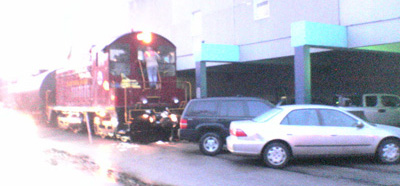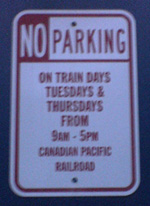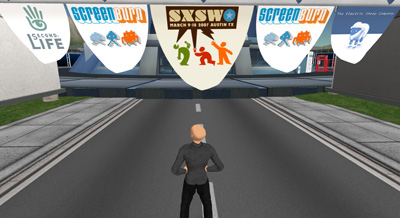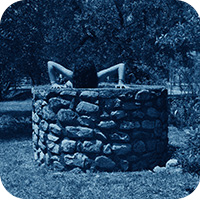Digging in the virtual sands
It seems like just yesterday that the Eternal Egypt website debuted. In fact it has been over three years. Image content has steadily been added since launch, but the most popular experience on the site remains the Virtual Environments, 3D recreations of important places in Egyptian history. On the website these environments are panoramic slices of fully-modelled locales. In 2004 there was no good way to put a 3D world into a browser (still isn’t, come to that) so we rendered off static QTVR’s from dozens of vantage points. Compelling, but clearly a step down from the actual, navigable models.
Ah, but there’s more to that story. The Eternal Egypt Kiosk was developed as a freestanding unit that displays the full environments, arcade game-style. These kiosks have been donated to museums around the world and are quite a hit, especially as Egyptomania has resurged of late.
Here are some screenshots from the three environments: the Tomb of Tutankhamun, the Great Pyramids and Sphinx, and Luxor Temple.
With a joystick and a few buttons you move about the world learning as you go with the help of text and image overlays. It’s a lot like a MMORPG, without the MM or the G. And that’s the thing, the kiosk is great fun, but it is utterly devoid of others. Like you’re the last archaeologist living. Gee, if only someone were creating a truly collaborative cultural heritage MMO …
SXSW Screenburn panels in Second Life
The good folks at Electric Sheep will be streaming the SXSW Screenburn track of panels onto Sheep Island starting on Saturday. If you can’t join us in Austin, how about visiting there? Who knows if the kinks will be worked out by Saturday morning for the first panel (mine), but we’ll be in there if all’s well. Nothing like sniping at panelists from the metaverse.
Sheep Island this-a-way.
A bit more.
Dude, where’s my car?
Some people misplace their car keys. I misplace my car. Often. See, I don’t drive very much, commuting to work by train as I do. And I park on the semi-anonymously gridded streets of Chicago. Add to that the frequent dustings and dumpings of snow and loaning it to friends in the neighborhood and it can be damn hard to find.
Enter Twitter. I’ve been wanting to do something with this much-buzzed, nanoblogging tool, but I really didn’t think my daily minutiae interesting enough to submit. (And I still don’t.) Hell, this blog is boring enough.
But as a mini-blog of my car’s location, it is absolutely perfect. I give you …
Don’t steal my car please. Oh, and someone add geotagging to Twitter. That’d be nirvana. (Update: thank you very much.)
Shudder
Yesterday I watched two extremely disturbing movies, Open Water 2: Adrift and Jesus Camp. One was infinitely more troubling than the other.
Open Water 2 is a sequel only in that it uses the same premise as the first which is simply and completely this: people stranded in the water at sea. Horrible, of course, but this one tries to up the ante by plopping the bobbing humans into the drink right next to a yacht that they cannot climb back onto. Whoops, forgot to put the ladder down! Panic ensues. People die. But wait there’s more. Did I mention that there is a baby who’s been left on board the boat? And a monitor on deck that faithfully transmits her hungry, neglected wailing to the stranded floaters (including her parents) boatside? Sound awful? It is. Most movies of this ilk ask for a generous suspension of disbelief, but Open Water 2’s premise manages to be completely unbelievable yet still disturbing. I don’t recommend this movie if you are a poor swimmer, afraid of the water or being alone, a parent, or if you’ve ever been a child.
But the stomach-churn caused by Adrift pales in comparison to Jesus Camp, last year’s documentary about an evangelical summer camp for young Christians. I actually had to turn away a few times. Simply couldn’t watch as little kids trembled and cried and threw themselves to the ground for God. The adult organizers of this camp are truly scary as they prompt the kids into ever more ridiculous shows of their faith. The implicit — and a few times stated — impulse is that if the Muslim world is creating armies of mindless devotees in madrasas then Christianity best do it too. What’s so troubling is how mature these little kids act. Like they are reading from a script. There’s absolutely no shred of free-thinking or even childishness. And that’s the great shame: to be raised in an environment of such unquestioning dogma that the wonder and curiosity of childhood is not even an option.
I’d rather be the kid trapped on the boat, frankly.
Ghana@50

Today, the nation of Ghana and its sizable diaspora celebrate fifty years of independence from colonial rule.
My family, while not Ghanaian, feels a special affinity for the country. About six years ago, we first met Margaret Kumi, an experienced nanny looking for a new family. In short order she was part of ours, and we part of hers. She introduced us to the Twi language, Ghanaian foods, authentic kente cloth and a world much beyond our own. Margaret is no longer our nanny. She’s more like a grandnanny, a Poppins-esque treat for the kids.
Seems like just yesterday I was getting emotional for a country I’d never been to as they marched further into the World Cup than anyone thought.
And mark your calendar Chicagoans. Ghanafest 2007 is right around the corner.
Paleocomputing

Anybody out there sitting on vintage computing hardware circa 1972? (If so, why?)
Coudal Partners is creating a great short film (for which I am an Executive Producer) and they need some help for their set. We have a few options, but could use some more.
Not familiar with Coudal’s film work? Well, the Copy Goes Here.
Head south, then southwest, then split the difference
SXSW Interactive is a little over a week away. I’m excited to be leading the first panel of the festival on virtual worlds called Terraforming the Internet. Even happier to announce the confirmed speakers.
Ben Batstone-Cunningham, Alt-Zoom Studios
Jan D’Alessandro, Meez
Eric Rice, Slackstreet Studios
Bill Victor, Halcyon Worlds
Talented, experienced, articulate, all of them. I am told they are mostly well-groomed. But don’t let grooming be an issue. If you’re in town for SXSW don’t let a Friday night hangover be an excuse not to come to our panel Saturday morning. Makes for a better discussion.
If you’ll be in town and want to meet up, drop a line.
And if you won’t be in town, why not? How can you pass up a conference with panels like Web Hacks: Good or Evil (or: Welcome to Web 2.666) and
Game Perverts: A Robot, a DS and a Dot Matrix Printer Menage a Trois?
Or for that matter film screenings for Hostel 2 and Helvetica and music performances by Girl Talk and Hoodoo Gurus. Something for everyone!
Move it, sugar!
Remember the Urban scar tissue post? No, of course you don’t.
Well, it was about the way cities have of slowly assimilating unused infrastructure and how this becomes visible when you scale out, looking at the city macroscopically. The earlier post showed the way the buildings have been shaped by the tracks that are no longer there, a ghost-limb of transportation past.
But the very southern edge of the line is still in use. Twice weekly. It is called the Sugar Train and it delivers sugar to a confectionary. The tracks, embedded nearly flush with the pavement sans sleepers, slice through private backyards and parking lots. My gym prohibits parking on the tracks tuesdays and thursdays because of the delivery. Up until last week I had never seen this mythical train.

Turns out this delivery route is a fantastic pain in the ass for everyone involved. There’s a small army of engineers that walks with the engine and single car as it creeps through the north side. Gates have to be unlocked, backyard equipment pushed aside, and — in the case of my gym — owners of cars have to be found. Seems that twice a week the train comes to a stop at the club while the management goes elliptical-to-elliptical asking people if they parked on the tracks.

I stood outside with clearly-irritated trainmen as the massive engine belched and growled, mere inches from a car parked directly across its path. I struck up a conversation and urged them to exercise right-of-way, crushing the pathetic vehicles like matchbox cars. They declined. In fact, they eventually gave up and backed the train down the tracks to who-knows-where.
I love that this throwback train exists, but you have to wonder: wouldn’t it be easier to deliver the sugar by truck at this point? The train basically spends a full day inching through roadblocks that the city inadvertently lays across its way. I’d love to know what the actual story is. Why the train is still a better option for the candy factory.
Impaneled
This week I was selected for a panel. No, not that one. The day after returning from Russia I had to report for jury duty and was selected. Just what one needs to catch back up after two weeks abroad.
The trial was civil. Personal injury. Really the stereotype of an ambulance-chasing lawyer with a plaintiff trying to milk an injury for all it is worth. In July 2000 the plaintiff was riding her bike along a relatively busy road. The defendant was stopped at a stop sign, looking left at oncoming traffic. He let his foot off the brake to idle forward and did not see the biker crossing from the right. They collided. The biker toppled over onto her knee. Ambulance came. Away she went.
The biker wasn’t badly injured. No cuts, a few bruises, clothing completely intact. She hurt her knee the worst and that was the crux of the case. The emergency room sent her home with some pain med after a clear x-ray. The biker never went to see her family doc but went to a couple of orthopedic surgeons and a chiropractor. The former could never find anything wrong with the knee, though they did not doubt that she was in pain — a pain that she described as debilitating, if intermittent, and one that prevented her from biking and other exercise. She undertook physical therapy six weeks after the doctor advised it.
Therapy seemed to help, but for some reason she stopped. Then, three years and nine months later she went back to the doctor. He found water on the knee but at this point could not say whether it was a result of the impact or of non-use.

The plaintiff wanted $6,000 in medical bill compensation, about $1.7k for salary lost, $25k for loss of normal life, and $25k for pain and suffering.
As on the only other jury I’ve been on, the drama and intensity of persuasion that went on in the jury room far exceeded that in the courtroom. The jurors actually elected me foreman — which was just as well; I wanted to get out of there as soon as possible so I got to control the pace of deliberation somewhat.
It came down to the bizarre gap of time between treatments and the sense that if she truly was in debilitating, normal-life-altering pain that she would have done something in the intervening years. That her lawyer was a bumbling slimeball and the defense attorney was sharp and concise didn’t help her case at all. In the end — though there was one initial juror hold out (isn’t there always?) — we arrived at unanimity by agreeing that a sufferer bears some responsibility in the successful outcome of one’s treatment. That is, if you smack me in the head with a bat, you are at fault. But if my doctor insists I need surgery and I refuse, I can’t hold you liable for what happens because I declined surgery. This is what happened with the biker and her strange lapses in treatment and physical therapy.
We awarded her recompense for most of her medical bills up until the gap in treatment. Nothing for salary. Uh, hello, it was a salary not a wage and she testified that the doctor gave her a note for work so that she’d be paid for the missed time. Nothing for pain and suffering. Nothing for loss of normal life. In a sense, a victory for the defense.
One thing we debated a bit in the jury room was the complete absence of mention of insurance. Some jurors really wanted to focus on it. Did insurance decline to cover? But since it wasn’t mentioned we couldn’t debate it. This irritated some jurors.
So, after two days on the Cook County payroll I was $34.40 wealthier and infinitely further behind in work. I will say that it was interesting to spend a week in China then a week in Russia then come back to the USA to engage in one of the only modes of direct civic engagement short of voting or military service. I’m not saying I was humming the national anthem or anything. Just agreeably content to be reminded of something quintessentially American.















